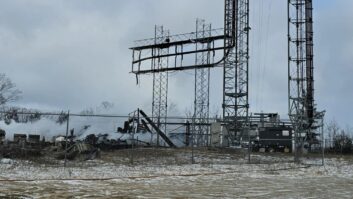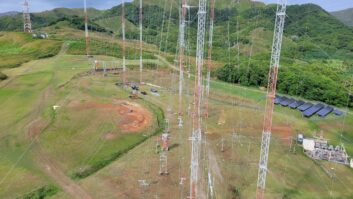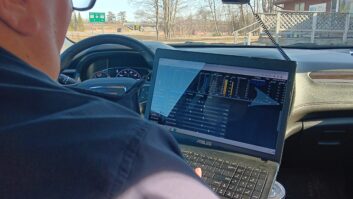Sierra H: The Transmitter Goes Over the Mountain
Mar 8, 2013 5:01 PM, By Richard White
The summit of the Bradshaw Mountains rises more than 8,000 feet above ground level in central Arizona’s Sonoran desert. Approximately 66 miles north of the Phoenix city limits, the transmission facility for two Sierra H Broadcasting FM stations is situated near the highest mountain peaks, among the Ponderosa Pines and short-horned lizards.
The location is certainly prime real estate for high-power FM transmission, but not without its challenges when modifying an outdated RF facility.

Klein White Broadcast Engineering is a full-service design and engineering firm that primarily serves the Phoenix area. Sierra H Broadcasting essentially hired us to install a transmitter for KNRJ-FM, the second of two stations to consolidate into the mountaintop facility.
The facility was already home to KAJM-FM, having moved in four years prior. At the time of the KNRJ move-in, KAJM was operating a Nautel NV30 with half of a Harris Platinum Z-16 transmitter in backup mode. The Platinum Z had once operated as the main 16kW transmitter, but took a series of lightning strikes — more than 14 in one night — rendering it nearly useless. It was rebuilt as a double-cabinet 10kW transmitter (single-phase) and put into backup.
Meanwhile, the previous engineering team installed the Nautel unit — a robust and reliable transmitter, but too enormous for this project on two levels. First, a 30kW transmitter for a 15kW TPO was an unusual choice (IBOC had been considered, but then decided against); second, the large footprint took far too much room in a space-challenged, 22×22-square-foot building.
The big question: How do we move a second transmission system, complete with main and backup transmitters, into a building with almost no additional space?
The answer: A near complete redesign.
– continued on page 2
Sierra H: The Transmitter Goes Over the Mountain
Mar 8, 2013 5:01 PM, By Richard White
Site evaluation
There is no question that a site this remote requires backup transmitters. It takes three hours to reach the facility on a clear day. The winters here bring snow — up to 2.5 feet at the time of writing — and it takes a Snowcat to reach the site. Delivering a completely new system could take days, with devastating effect to a station’s bottom line from being off the air.
This left little choice beyond retiring the current transmitters. The Platinum Z was removed, rebuilt and resold as two separate 10kW transmitters. The Nautel removal was a more difficult proposition. The double-wide cabinet, nearly 8′ long, was inseparable. We dragged it from the building with a tractor and set it in a pick-up bed for transport down the mountain.
The major requirement for the new transmitter was size versus output power, equally important in both space considerations and the fact that only single-phase electricity is available at the site. This steered us toward solid-state digital transmitters, which would avoid having to add rotary phase converters to make power.
We decided to purchase four Harris Flexiva 20kW transmitters. The Flexivas offered the compact footprint we needed to fit two main and two backup transmitters in a space that traditionally had space for only one transmitter and half a backup.
Though the stations need only 13.5kW from each transmitter to meet licensed power, the 20kW design offers additional headroom for additional services in the future. However, the distance from the studios — approximately 74 miles — means that both stations will operate in FM-only configurations for the foreseeable future.
The choice was made, but it wasn’t just plug-and-play. There was much advance work required to get the site in order.
Grounding, electrical and HVAC
The fact that the Platinum Z took 14 lightning strikes signified a serious grounding problem. The site is now very well-protected, with bonding rings inside and outside made with four-inch strap, and six chemical grounding rods surrounding the building to mitigate lightning strikes and electrical faults. LEA PowerVantage external surge suppressors provide additional RF system protection.
Most interior electrical work was redone, upgrading from a 400-amp to an 800-amp service. Prior building renters improperly tapped into electrical panels and left wires from previous installations bare and protruding from walls. This asks for trouble in RF environments where non-terminated wires left for dead can resonate RF, producing feedback. They also can attract static electricity and lightning. LEA DS30S inline surge suppressors provide additional interior protection for the new RF systems.
HVAC was itself a project, with modifications to a pair of Bard 6-ton wallmount, single-phase units. Site power is far from stable, and we’ve encountered interesting problems — notably that the digital controllers on modern AC units often lock up. Quick power interruptions are often the cause, so we stripped the digital controls and installed mechanical relays. When the power stops, the mechanical controls dial in like timed relays and restart the units after 20 seconds.
While an improvement, the overall AC system still lacks the required redundancy, and a third unit will be added in the spring. This unit will automatically turn on if one of the main units goes south to avoid overheating the building.
– continued on page 3
Sierra H: The Transmitter Goes Over the Mountain
Mar 8, 2013 5:01 PM, By Richard White
Transmitter installation and design
The Flexiva is a single-cabinet design that resembles an equipment rack. The 20kW model is built from two 10kW power blocks, with no external power supply or combining network required. All connectivity is internal. This makes it compact enough to fit four 20kW units in a 22×22-square foot building with other equipment racks, a combiner, dummy loads, air conditioners, service entrances, disconnects, surge suppressors and transfer panels — and room to spare for engineering service.
The high elevation makes transport a challenge, as previously noted. It’s nearly impossible to drive a huge transmitter truck up the mountain, and the Flexiva design allowed me to break the transmitter down into components that I could easily transport. This very much simplified the move-in process, as the rack was the largest piece to transport.

The first parts of the transmitter are installed.
The transmitters, each outfitted with Harris FlexStar exciters, were reassembled onsite. We loaded the cabinet set including power supplies and amplifier modules, and reattached the side doors once each transmitter was in place. A used ERI six-cavity U combiner was repurposed and reconfigured into a more space-friendly T arrangement to bring the entire RF system together.
At the same time we replaced an existing Moseley 6000 STL system with a Harris Intraplex STL HD T1 system. We additionally added Orban 8600FM units for on-air processing, and DaySequerra M2A-FM modulation monitors. The Orbans sound exceptionally nice, and we use AAC encoding on the Intraplex for the best possible audio quality and least amount of delay. It has worked very reliably, with only rare minor interruptions.
We plan to install an Intraplex HD Link 950MHz STL system when the weather breaks, and switch between the two units every 30 days or so. The terrain and distance from the studio involves multiple hops for a 950-based system, and will require some path analysis, new microwave dishes and multiple tower crews.
Exterior work on the tower was limited to re-tuning and double-slug tuning the existing six-bay ERI antenna. The previous engineers had the foresight to consider that the antenna would be diplexed down the road, minimizing equipment and labor costs on antenna and tower changes.
– continued on page 4
Sierra H: The Transmitter Goes Over the Mountain
Mar 8, 2013 5:01 PM, By Richard White
Fire on the mountain
With space in the transmitter site being at a premium the project was done in stages. Removing the Platinum-Z and NV30 transmitters and installing the new main Flexiva for KAJM while keeping the station on the air was first. Repositioning equipment racks and installing coaxial transfer switches was next. Retuning the antenna, installing the six-cavity ERI T combiner and the new main Flexiva for KNRJ followed. The last thing to do was bring both the station’s new backup transmitters up the mountain for installation.
As luck would have it, a forest fire broke out just as we planned to head up the mountain, cutting off access to the site. Within a day the fire had burnt down 16 utility poles, cutting off electricity to the site. The generator kicked in, and with 3,000 gallons of fuel and a burn rate of roughly 1,000 gallons a week we counted the days.
Ultimately, we lost power when heavy air tankers dropped water and slurry on the mountaintop to cover firefighters on foot who had been cut off trying to maintain containment lines. Our Cummins generator was waterlogged and power was lost, but firefighters saved the site.
It was at this point that we put the FlexStar exciter to the test. I located a hill in town for an emergency facility that kept us legally within out 60dB contour. After filing the FCC paperwork, we installed vertical dipoles shipped overnight from Shively, pulled the exciters from the backup transmitters, dialed in the needed changes and fired them up. The exciters proved stable and allowed us to broadcast at 35W, keeping both stations on the air until we could regain access to the site several days later to fix our generator and re-fire the mains.
Sight and sound
The exciter not only helps to produce good sound but also offers a built-in spectrum analyzer to better understand coverage and audio artifacts. Multiple metering points along the transmission line, as well as output from the combiner, offer additional insight into the overall audio picture. It’s helpful to evaluate the various samples and paths to gauge if any auxiliary equipment is tainting or coloring the audio.
– continued on page 5
Sierra H: The Transmitter Goes Over the Mountain
Mar 8, 2013 5:01 PM, By Richard White
The Flexiva itself offers several additional monitoring options, including front panel visuals and an IP connection with a richer graphical representation. We also interface with Burk ArcPlus remote controls so I can call in by telephone when necessary. An SNMP interface opens up an entirely different monitoring universe that we have just started to explore.
The transmitters have been stable, with just one glitch related to an air conditioning problem — and the main reason we’re adding the third AC unit this spring. The APC setting had inadvertently been turned off in one of the transmitters, and when an AC unit locked up the transmitter didn’t fold back power to compensate.

The transmitters and equipment racks installed and in-place
Eventually, a piece of transmission line failed, with minor damage to the directional coupler and controller board. The backup was put immediately into service and repairs to the main were quick and easy to perform.
Operational efficiencies
An emerging benefit of the transmitter installation correlates with the monthly operating costs. We initially couldn’t tell much difference between the Flexivas and the Nautel, but with two transmitters running for several months everyone is quite pleased with the electrical draw. They don’t jump around or spike and keep very consistent output power. This results in stable draw, which results in predictable monthly bills. The lack of fluctuations in power is especially helpful for the in-line surge suppressors. Additionally we have not experienced a single power supply or PA module failure to date.
As of press time we have made it through the rainy autumn season, which brings an assortment of storm-related electrical activity. With winter passing in the rearview mirror, it’s time to look forward to getting our HD Link on the air — and hopefully dodging any repeat forest fires this spring and summer.
Equipment List
Andrew dehydrator
APC AP7752
Belkin monitor rackmount w/built in KVM
Bird BPME display panel, power sample section
Broadcast Tools DMS-III, Silence Sentinel Basic
Burk ArcPlus, Plus-X AC-8, Plus-X ICRU, Plus-X IIU
Cummins 800A, Cummins/Onan propane genset
DaySequerra M2A-FM
Dielectric 3-1/8″ four-port motorized coaxial switch, dual switch controller
ERI six-cavity T combiner
Fostex RM-1
Harris Flexiva, Intraplex STL HD T1
Henry Engineering Powerswitch
LEA DS30S, Powervantage surge suppressor
Liebert GXT2 UPS
Middle Atlantic PD-815
Myat, Shivley, Dielectric 3-1/8″ rigid line and components
Orban 6300, 8600FM
White is president of Klein White Broadcast Engineering. He can be reached at [email protected].
March 2013
The 2013 NAB Show preview, streaming audio update, Sierra H updates its transmitter site, Field Reports on the Elenos ETG and Presonus StudioLive 24,4,2 and more….












